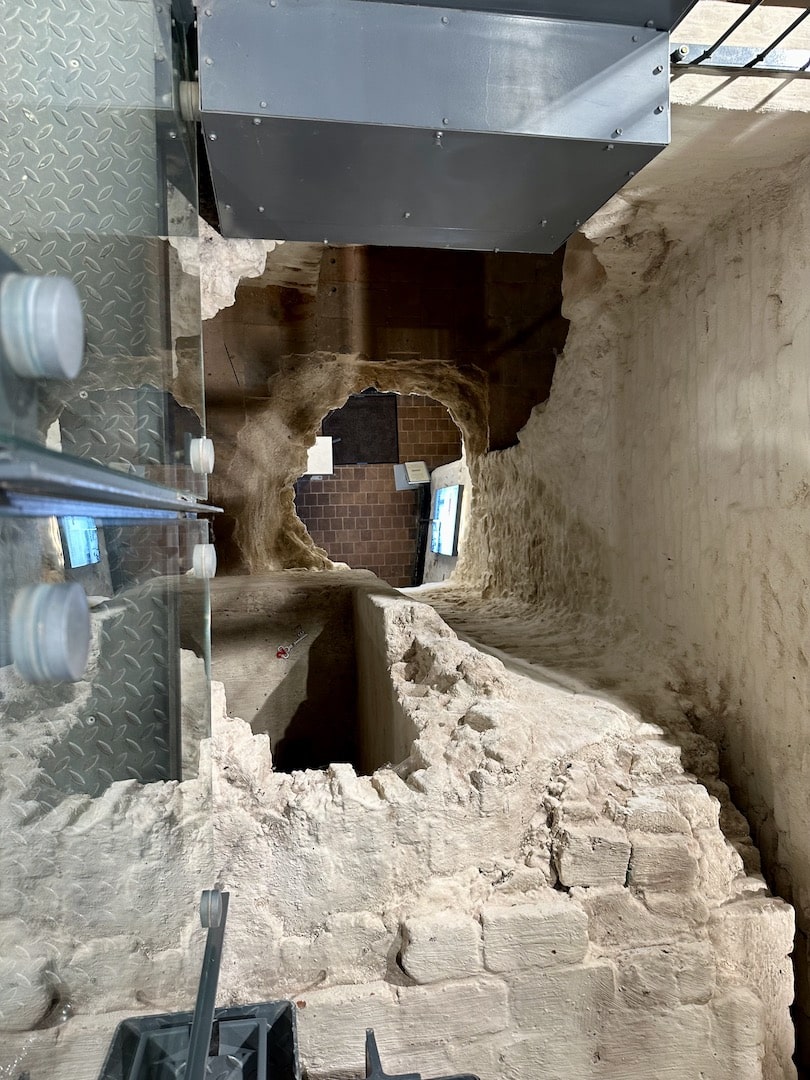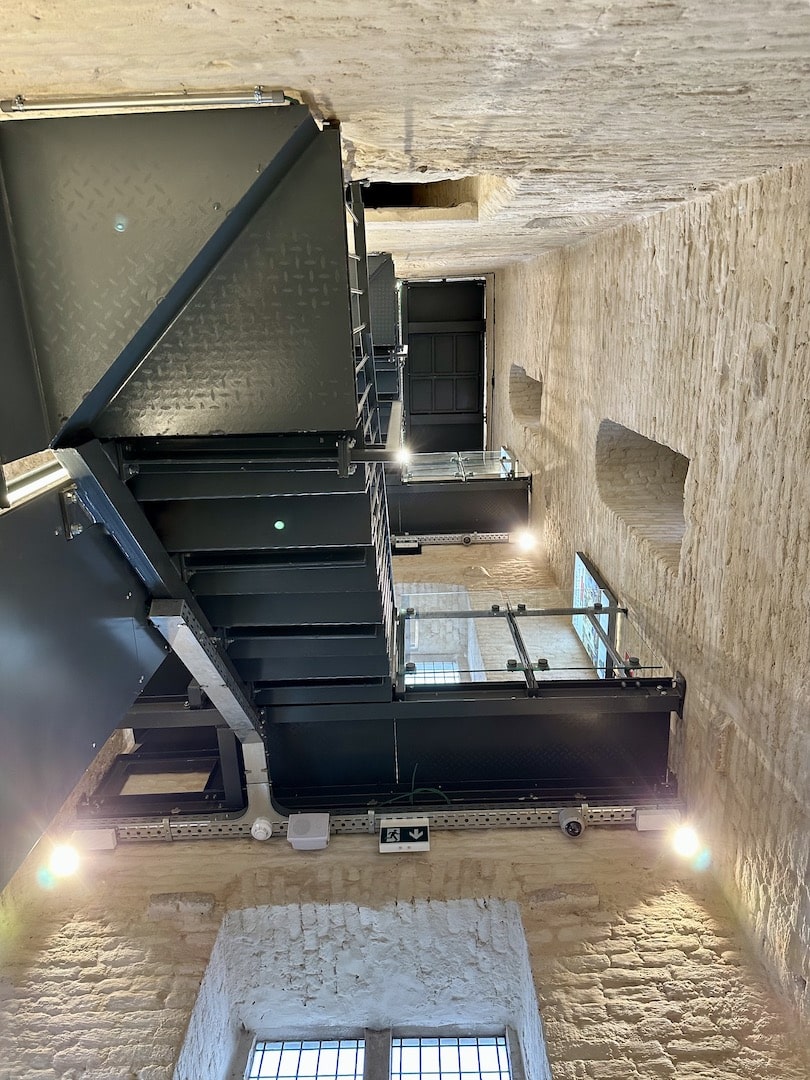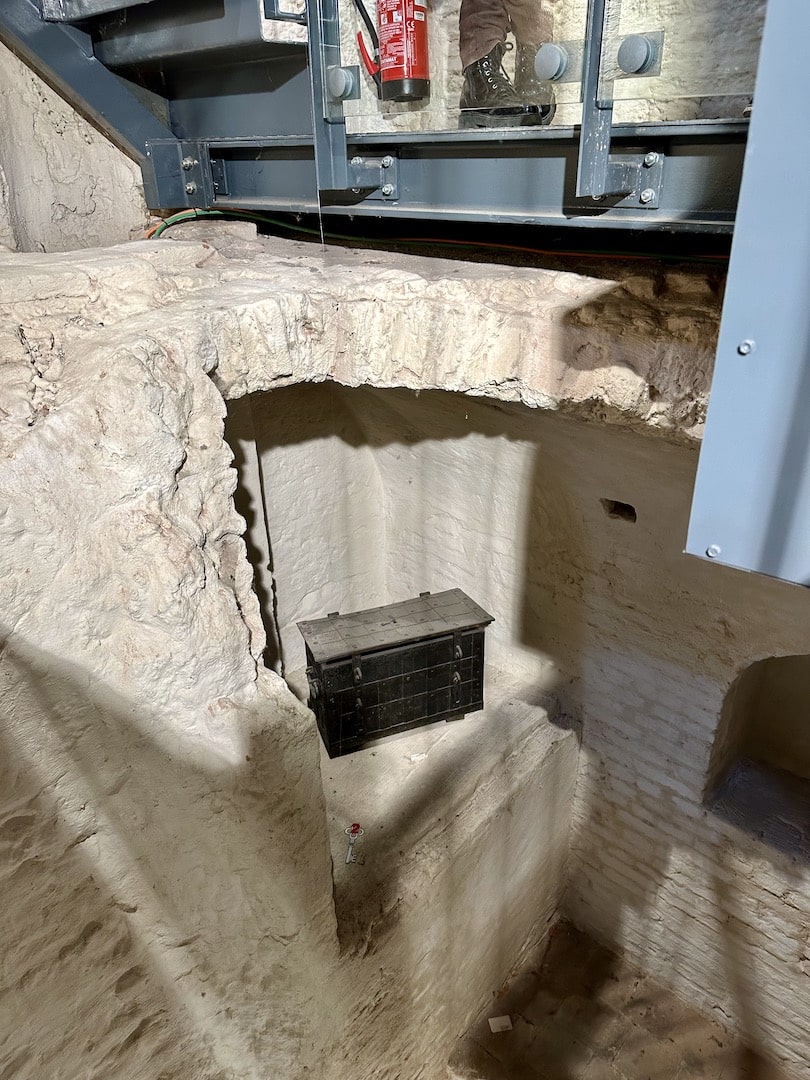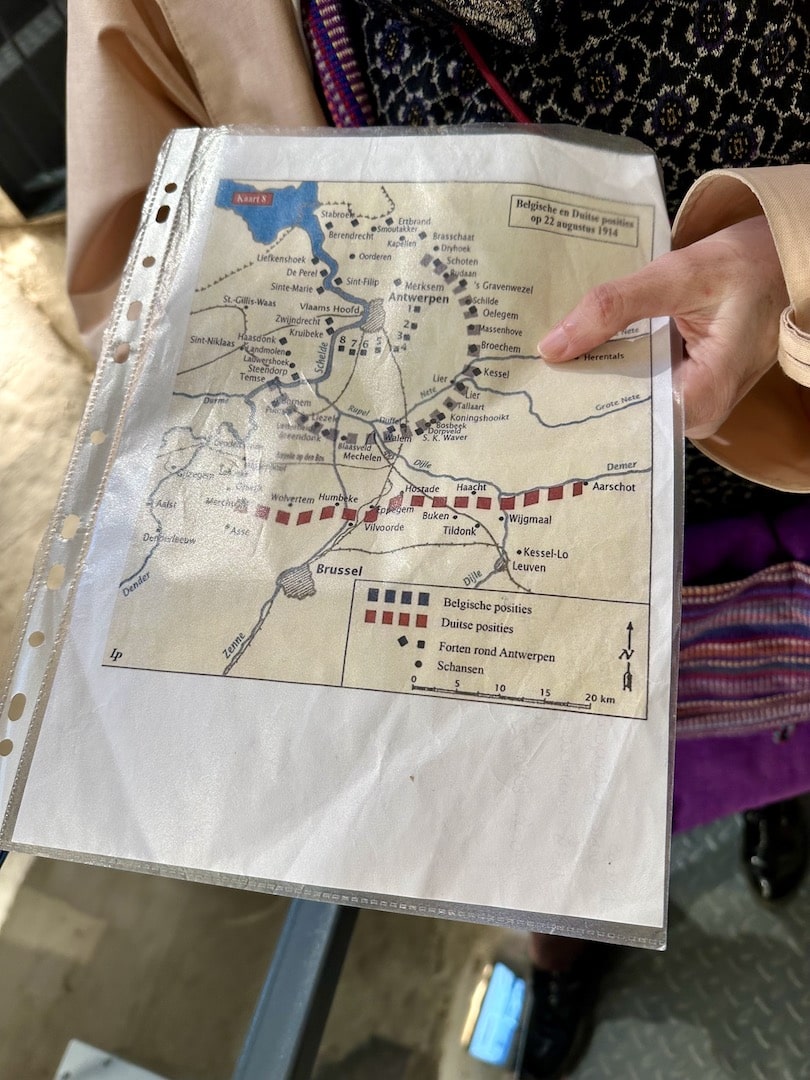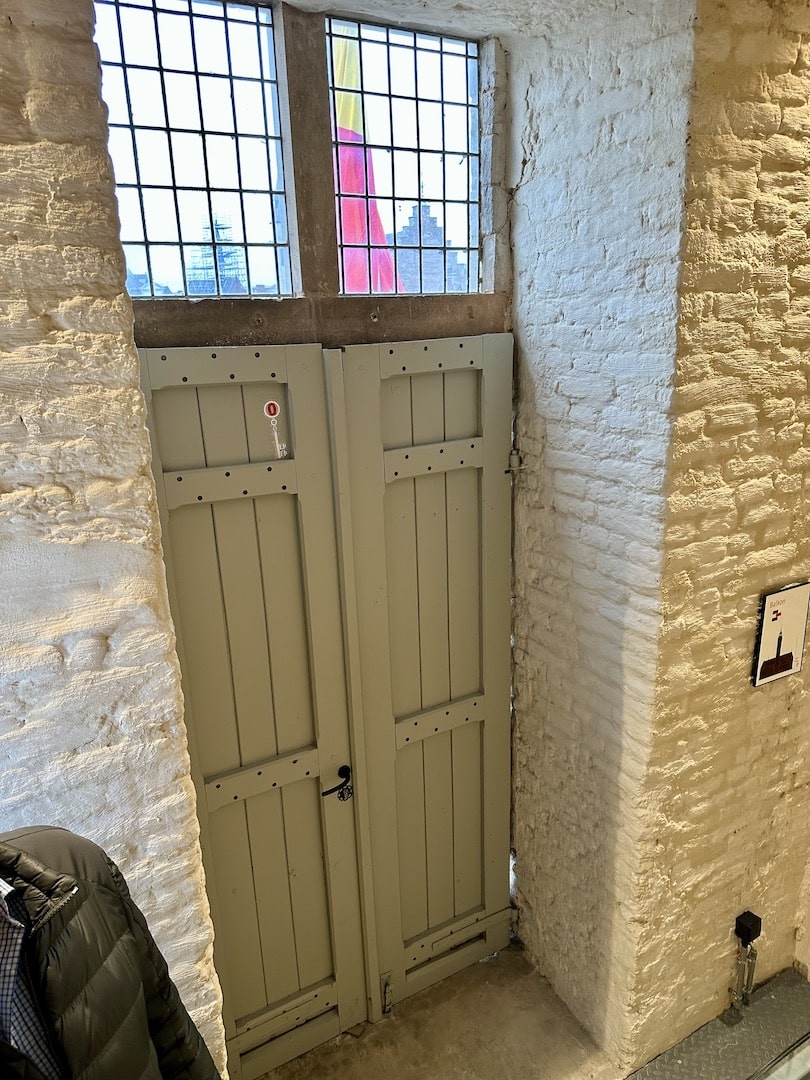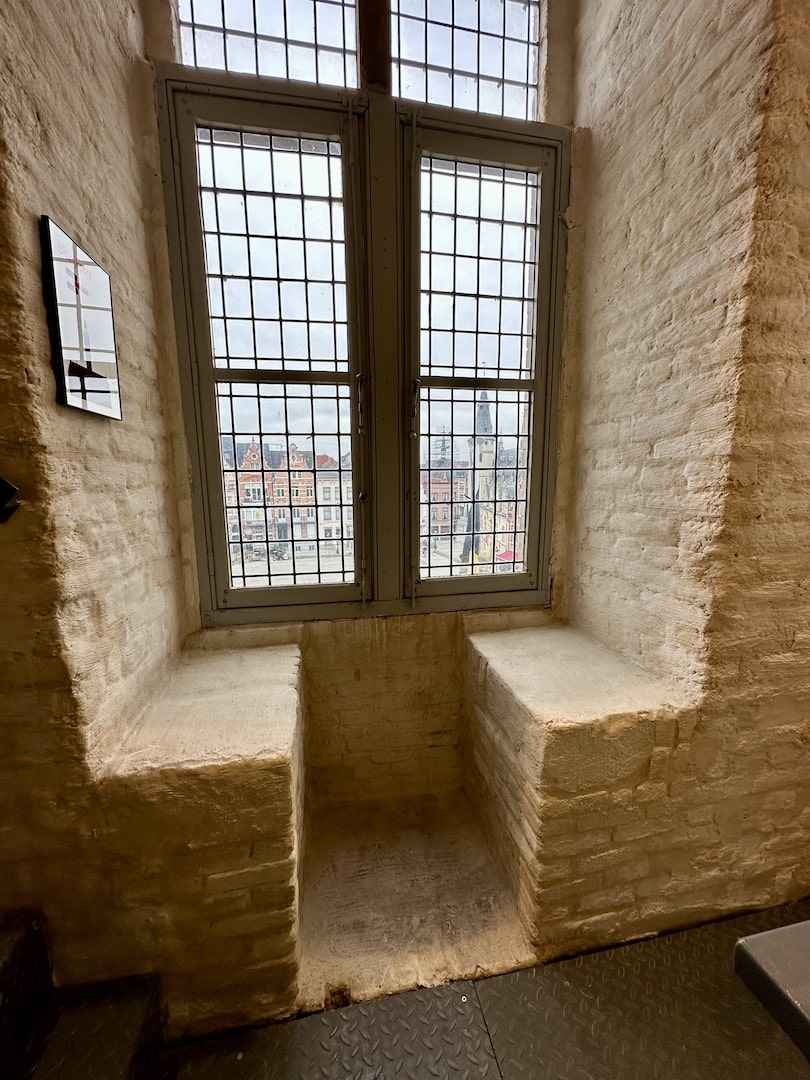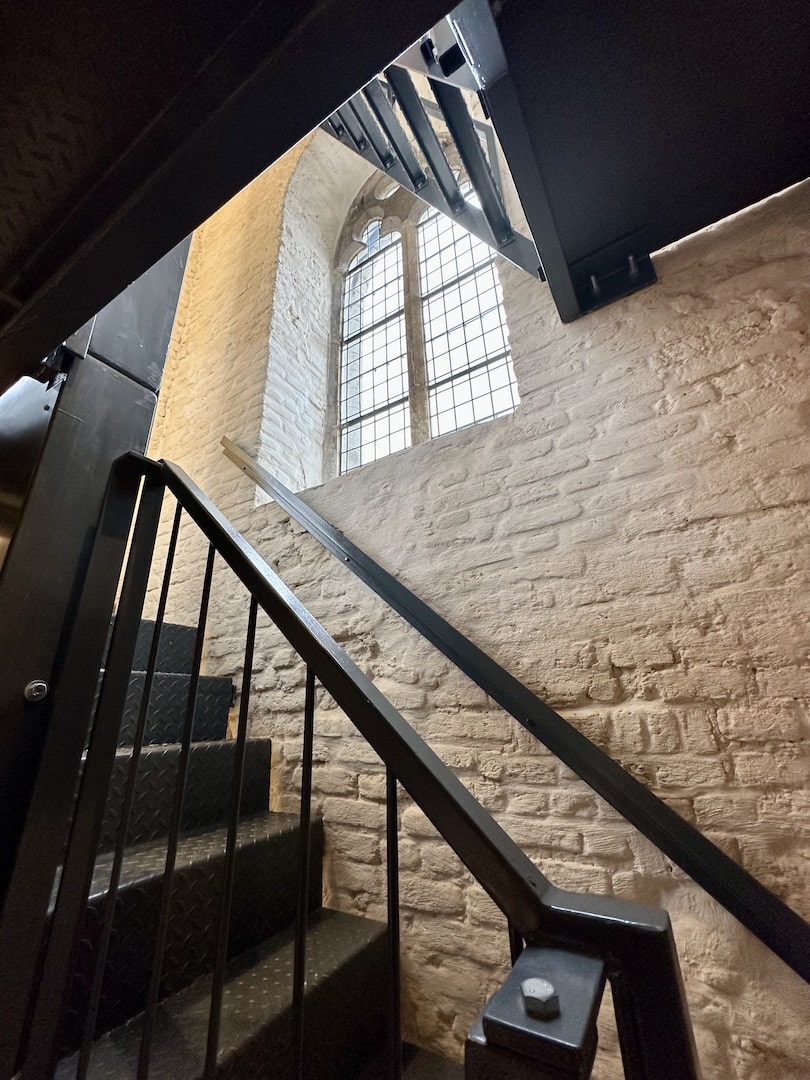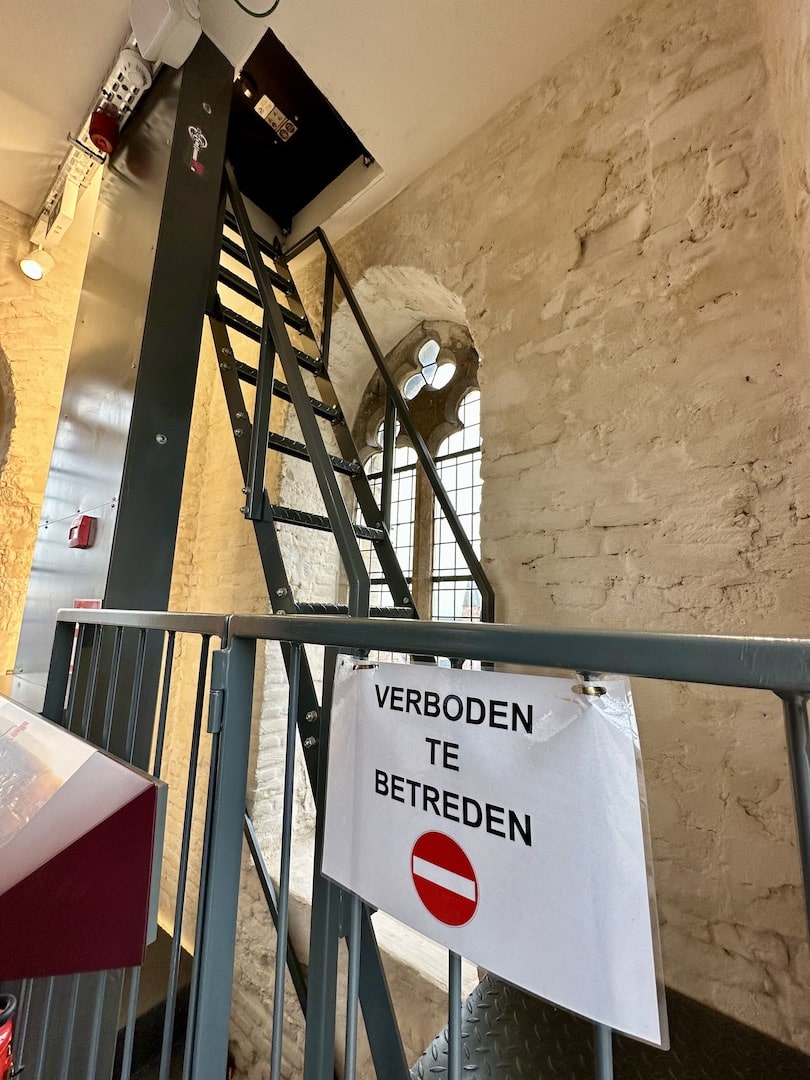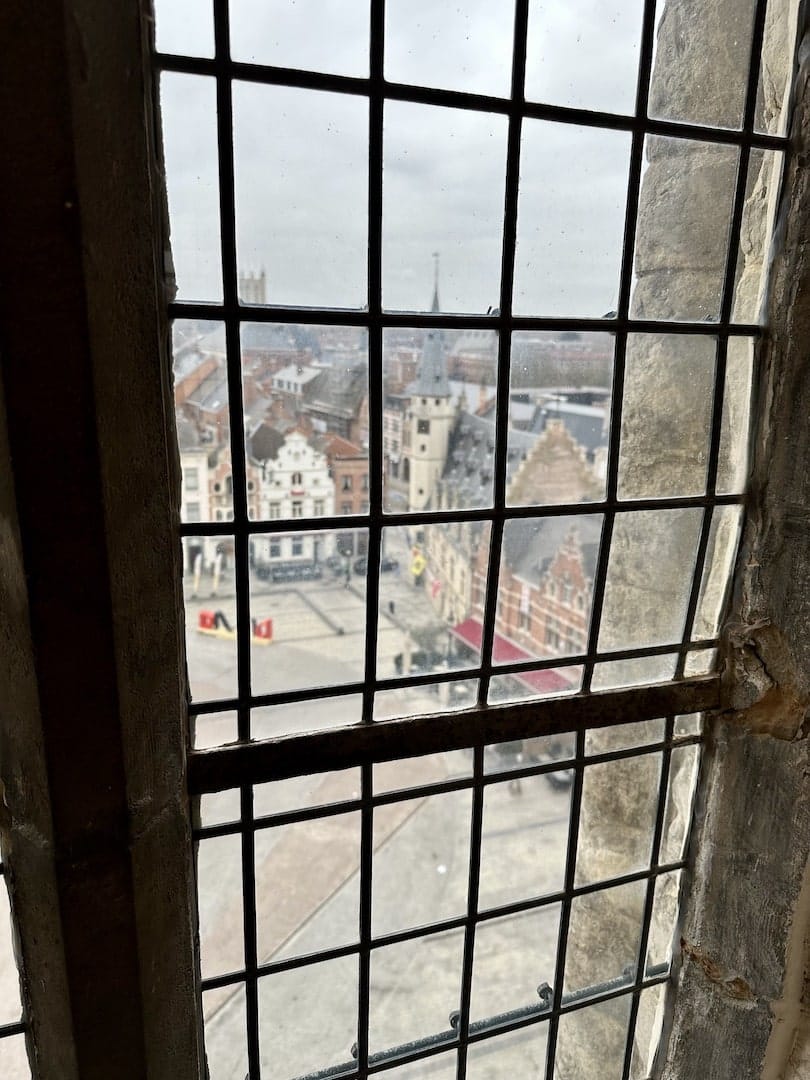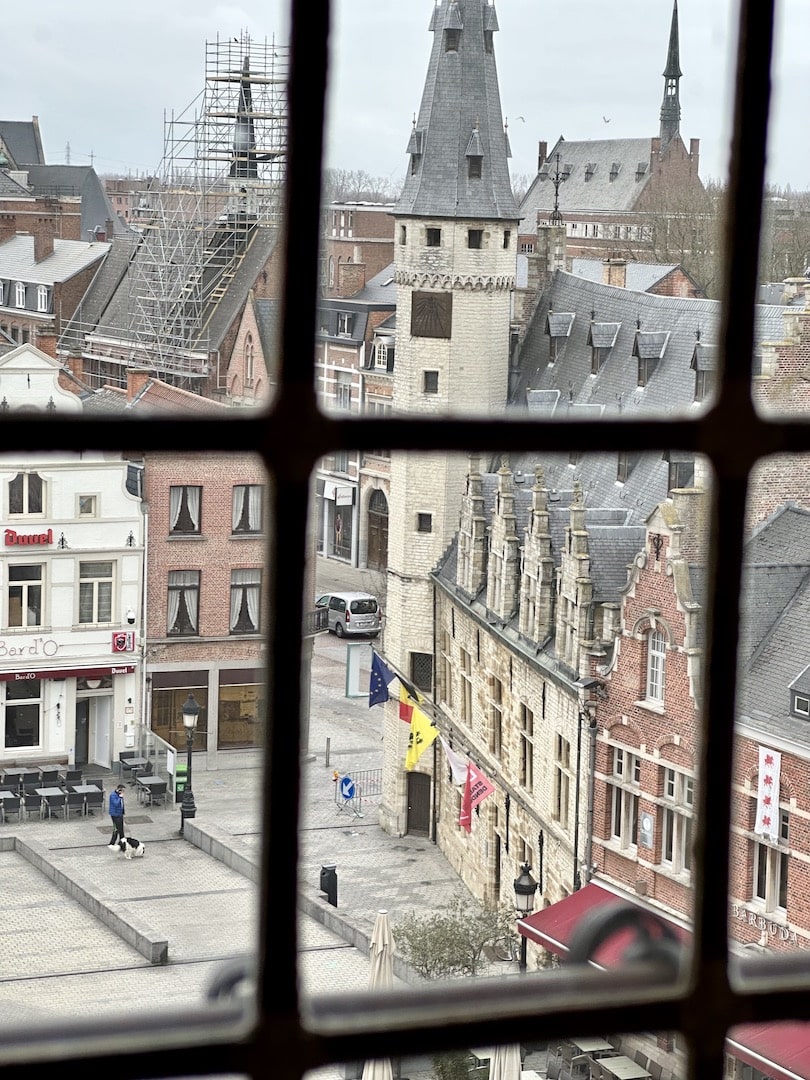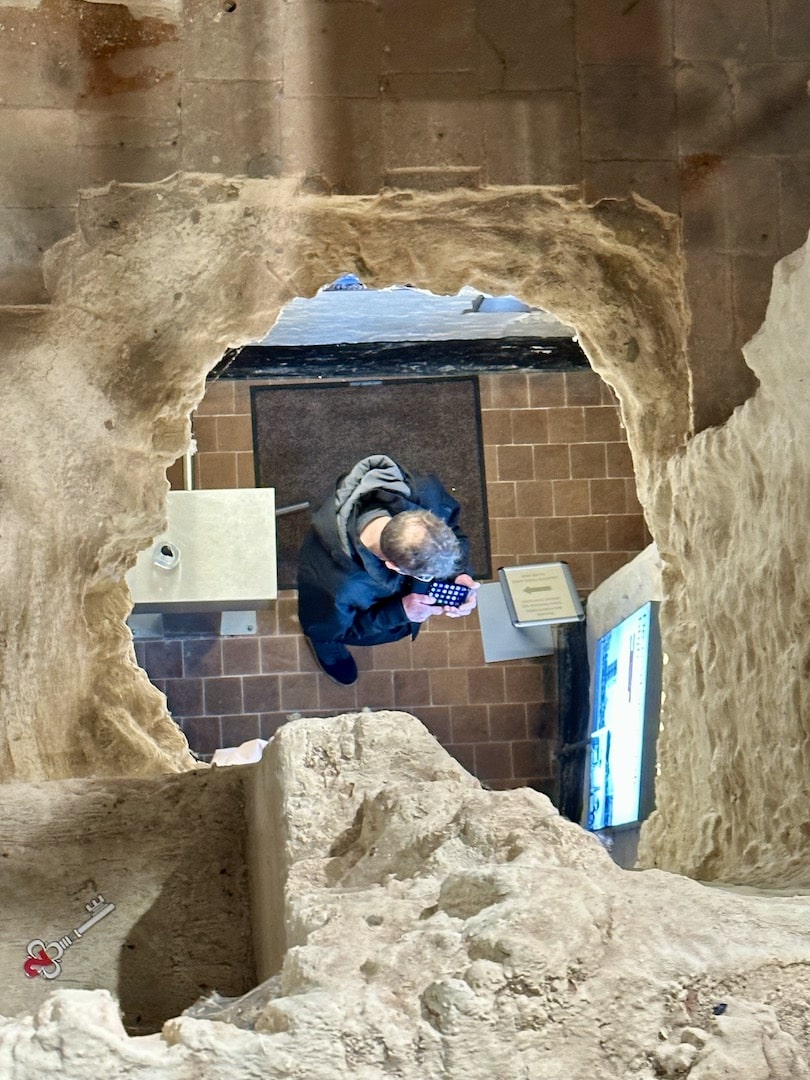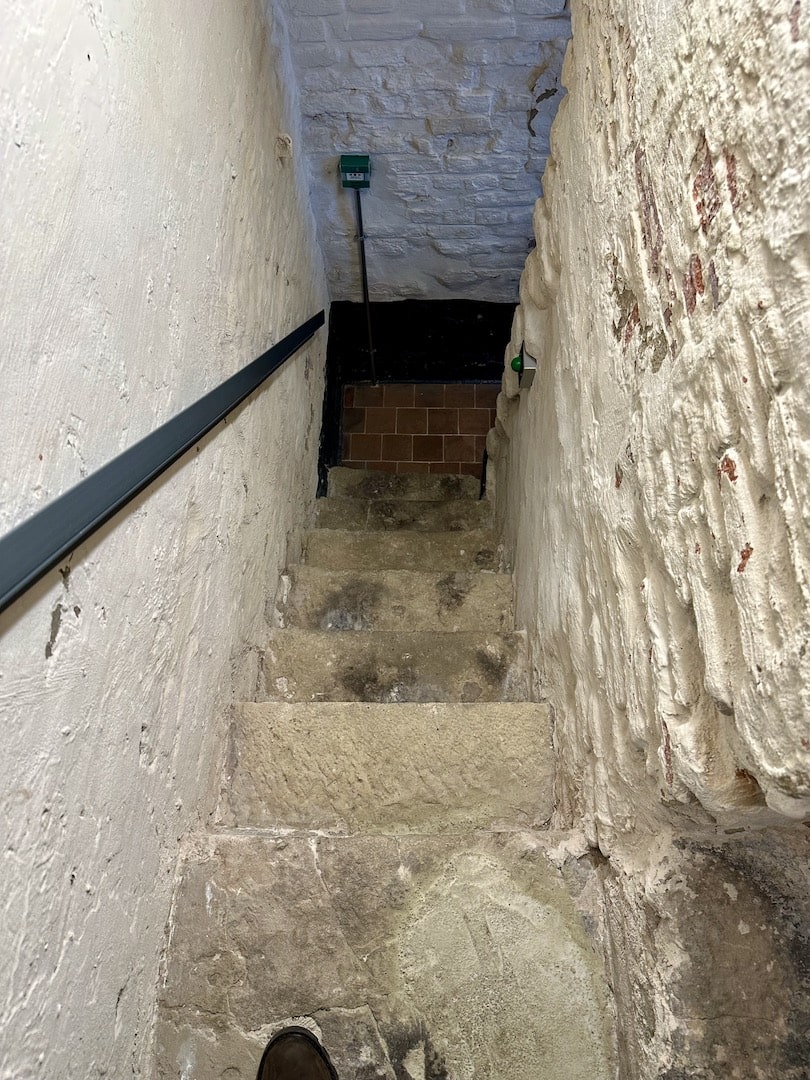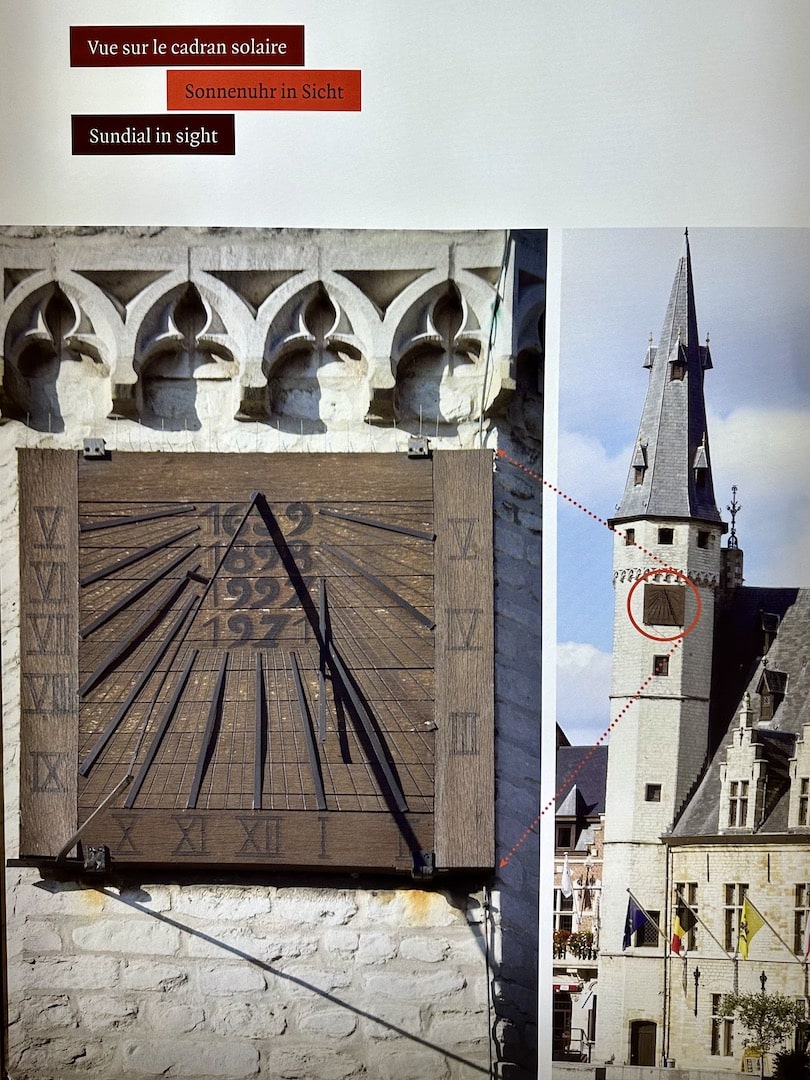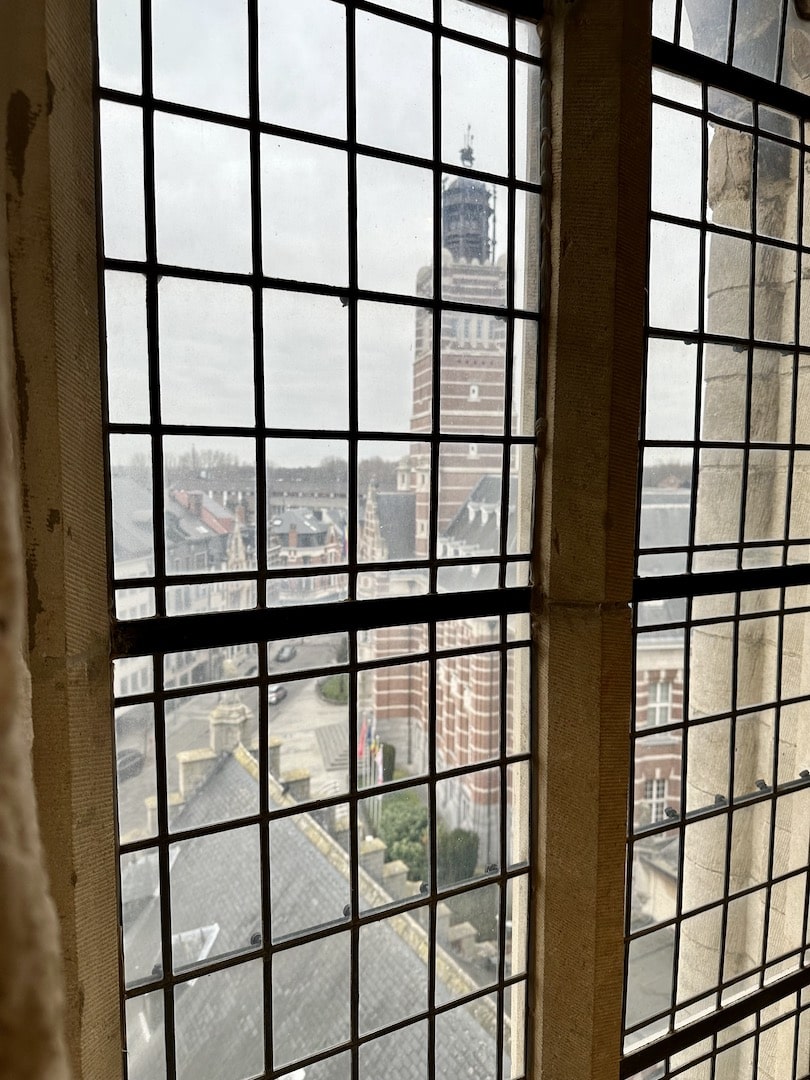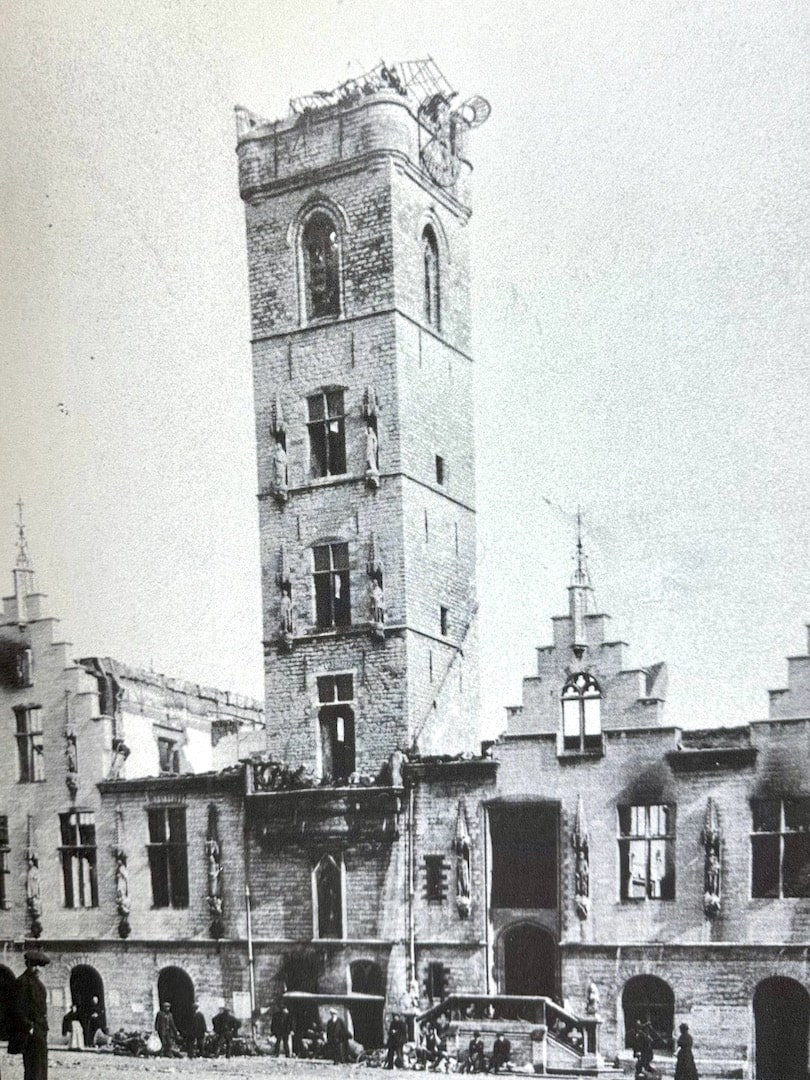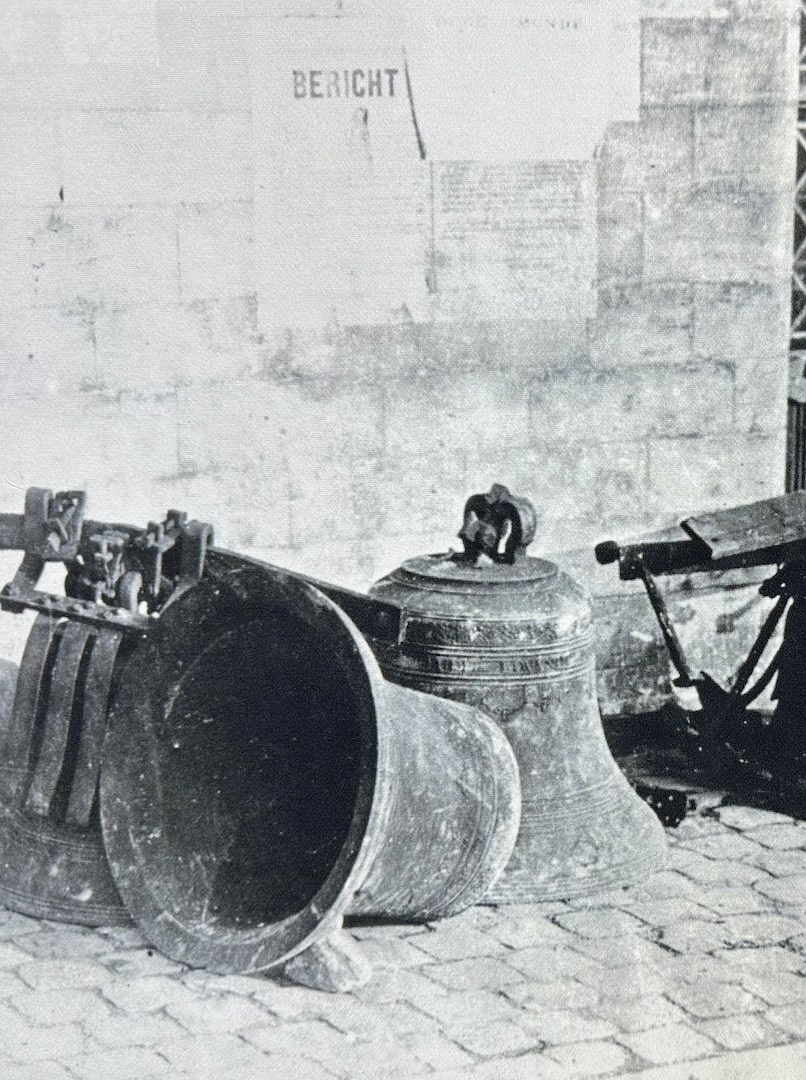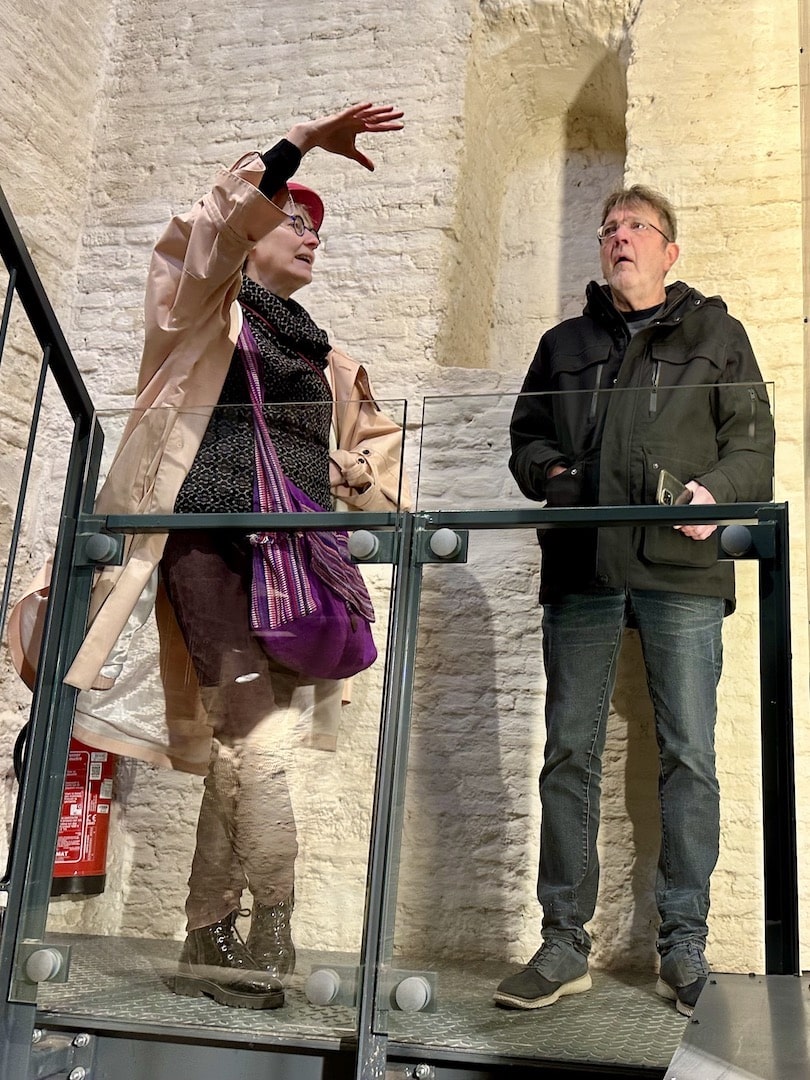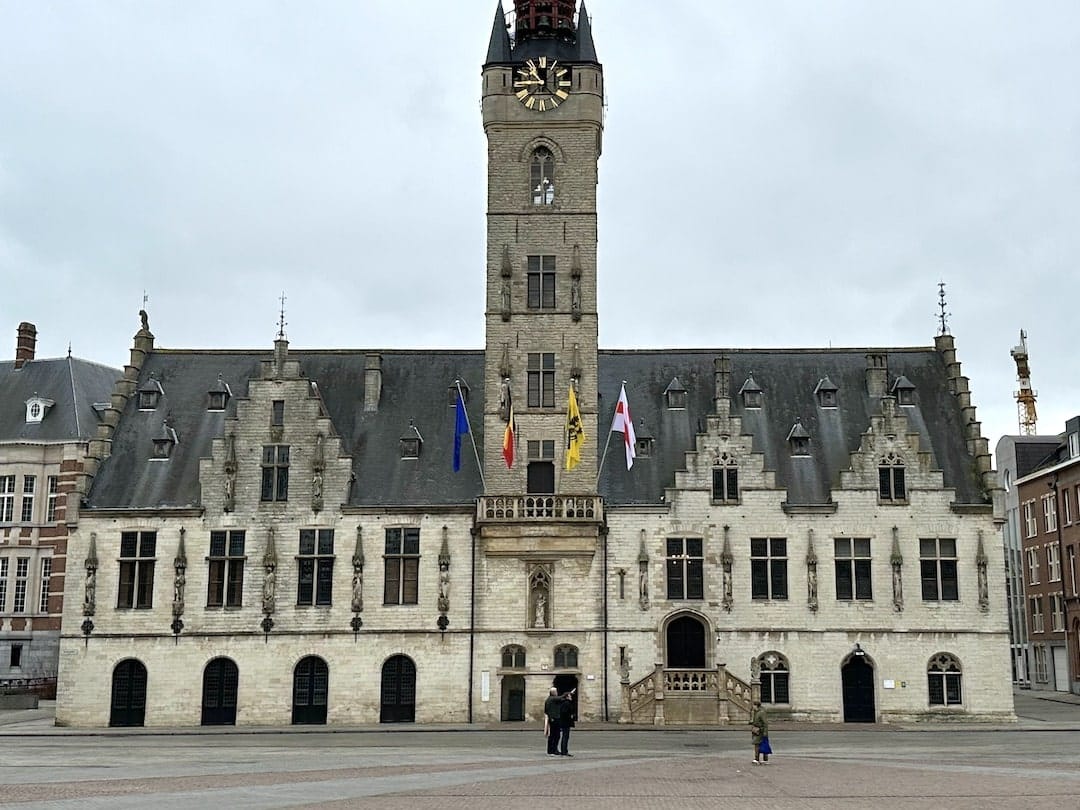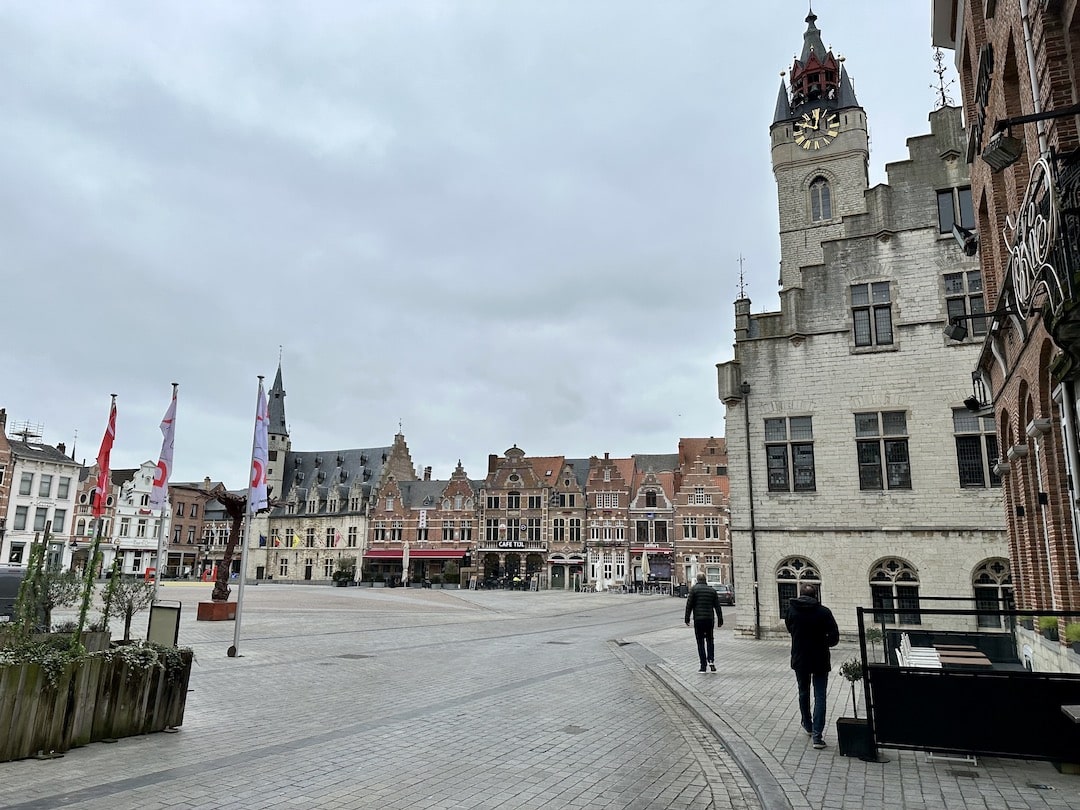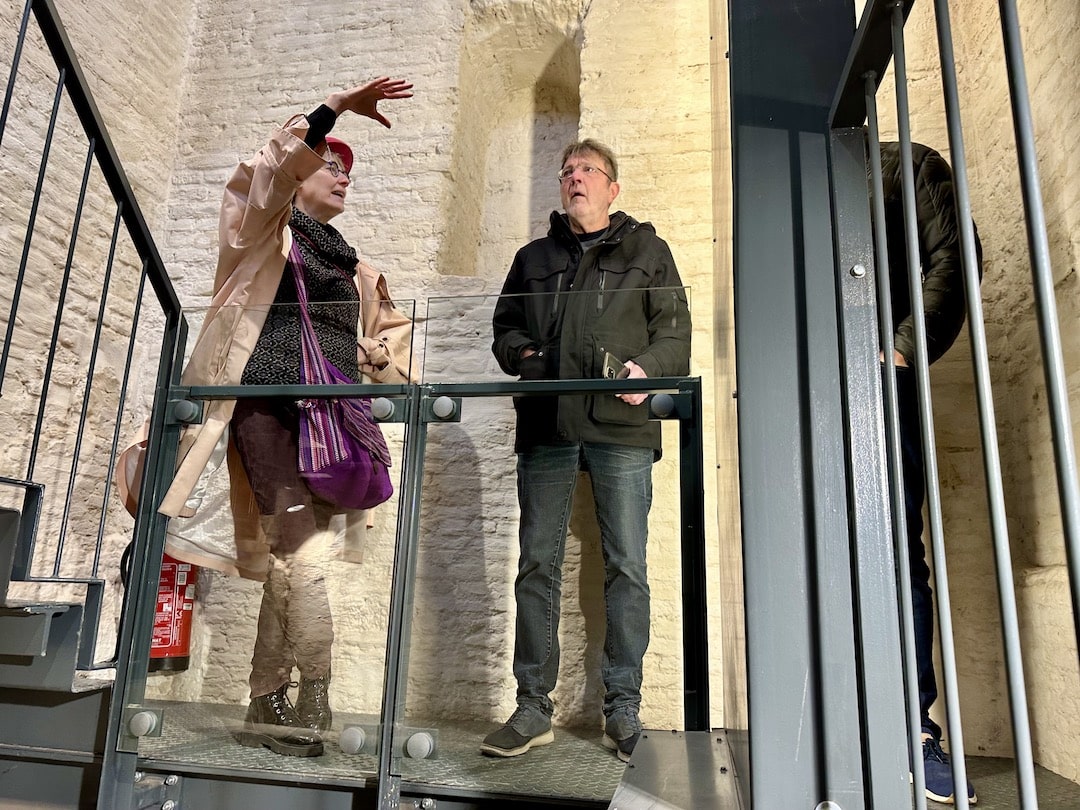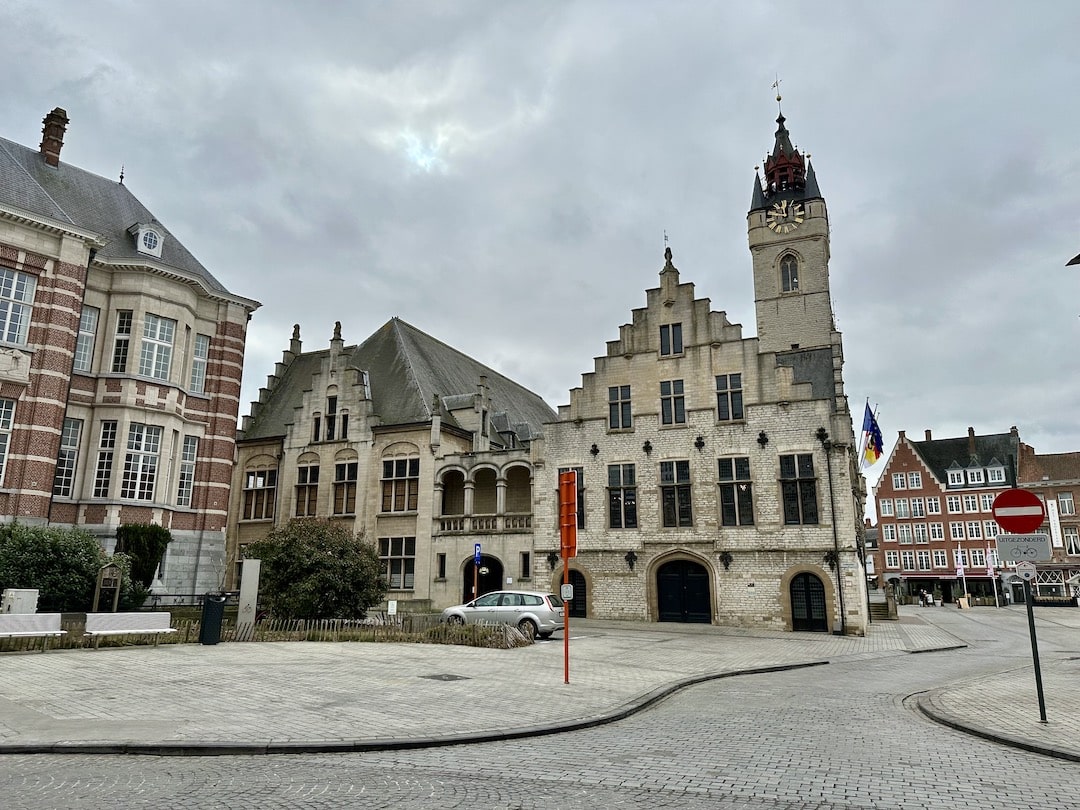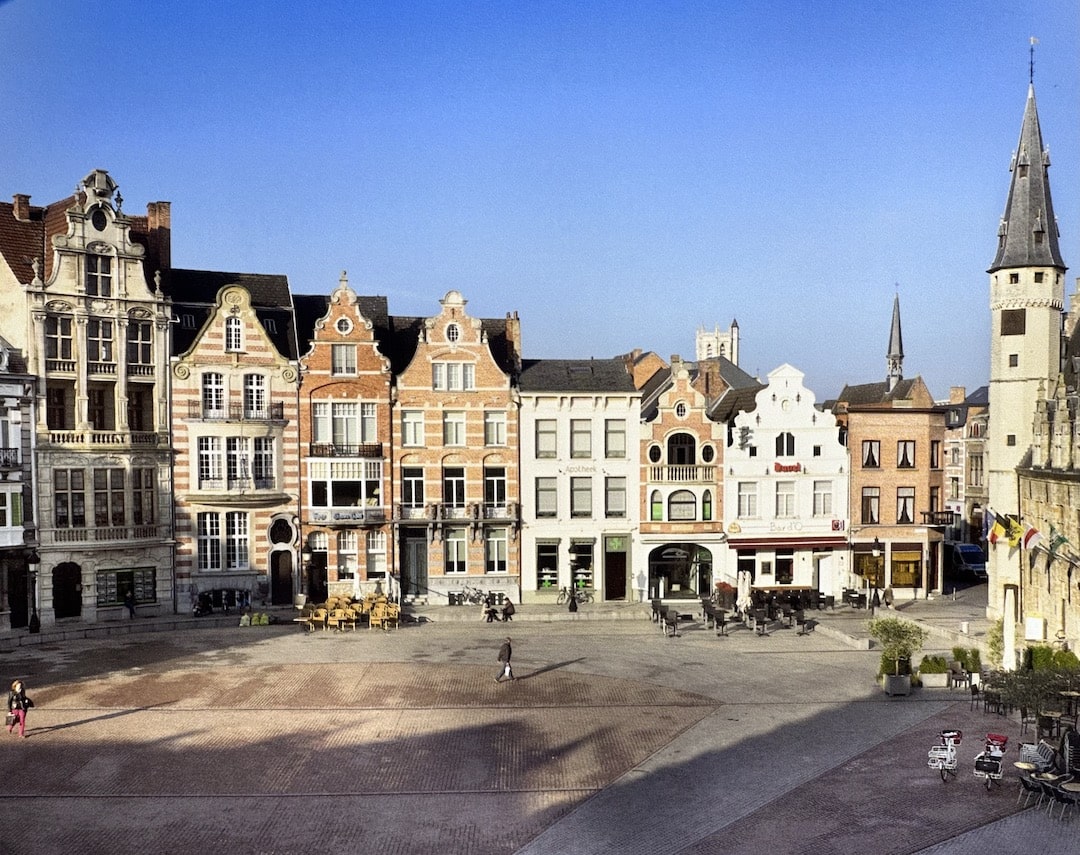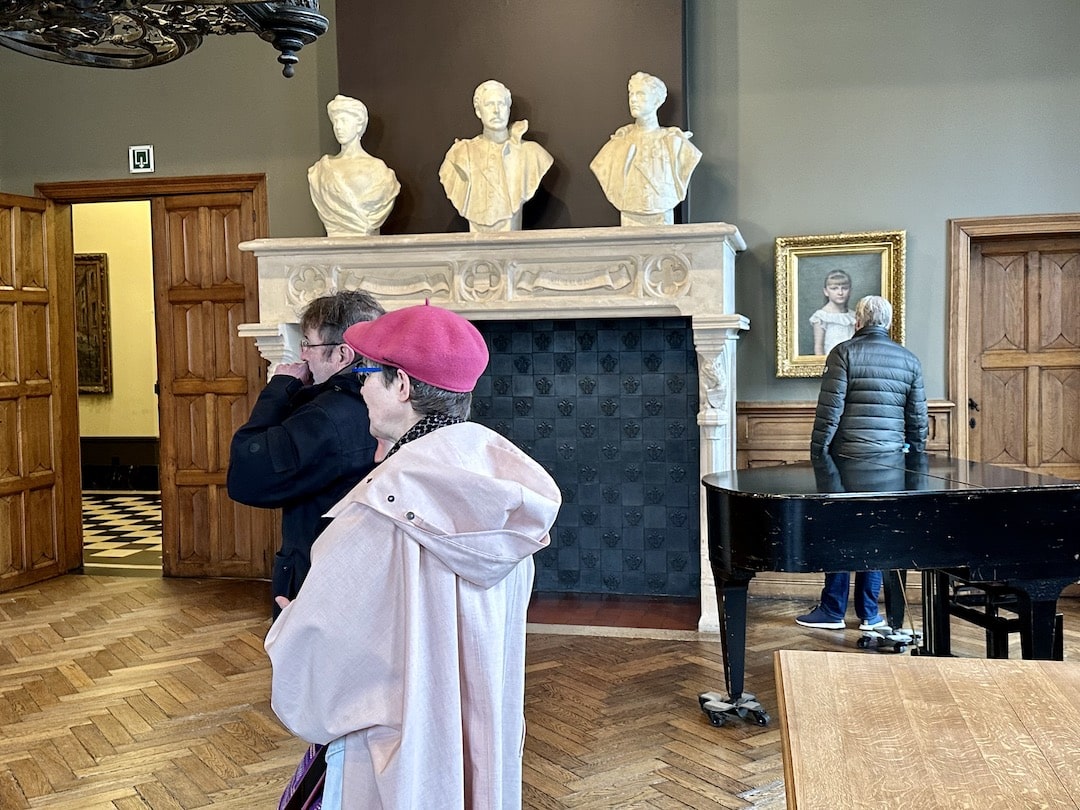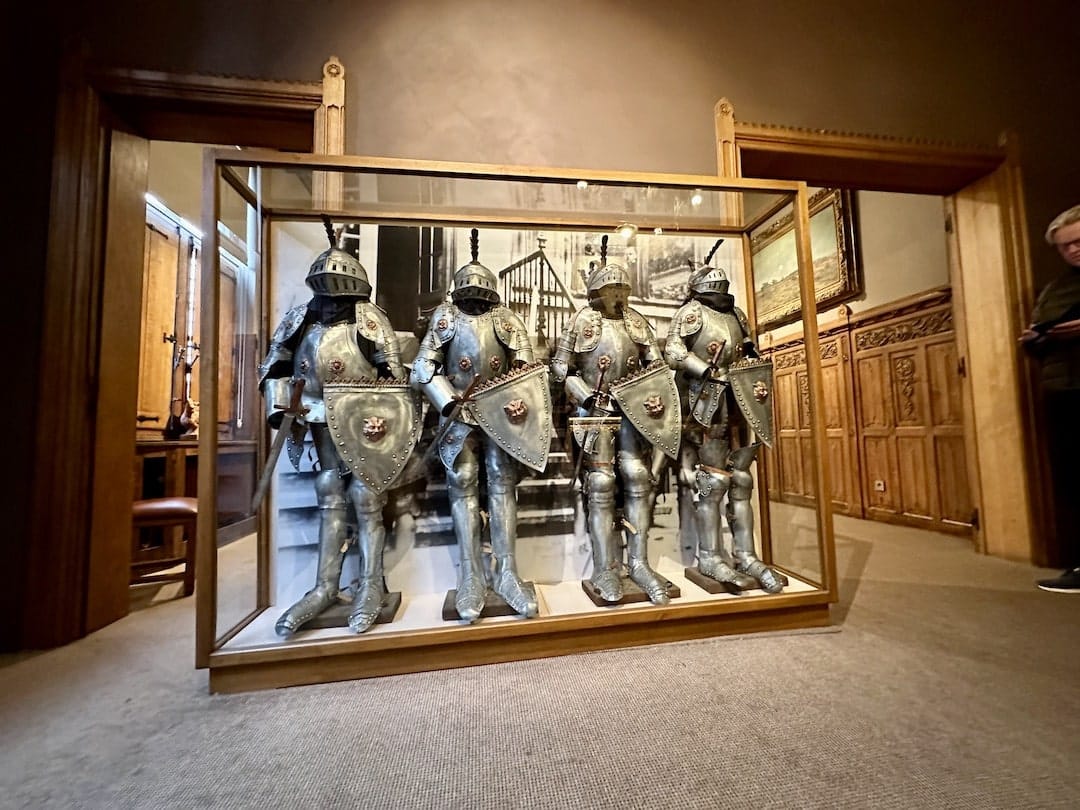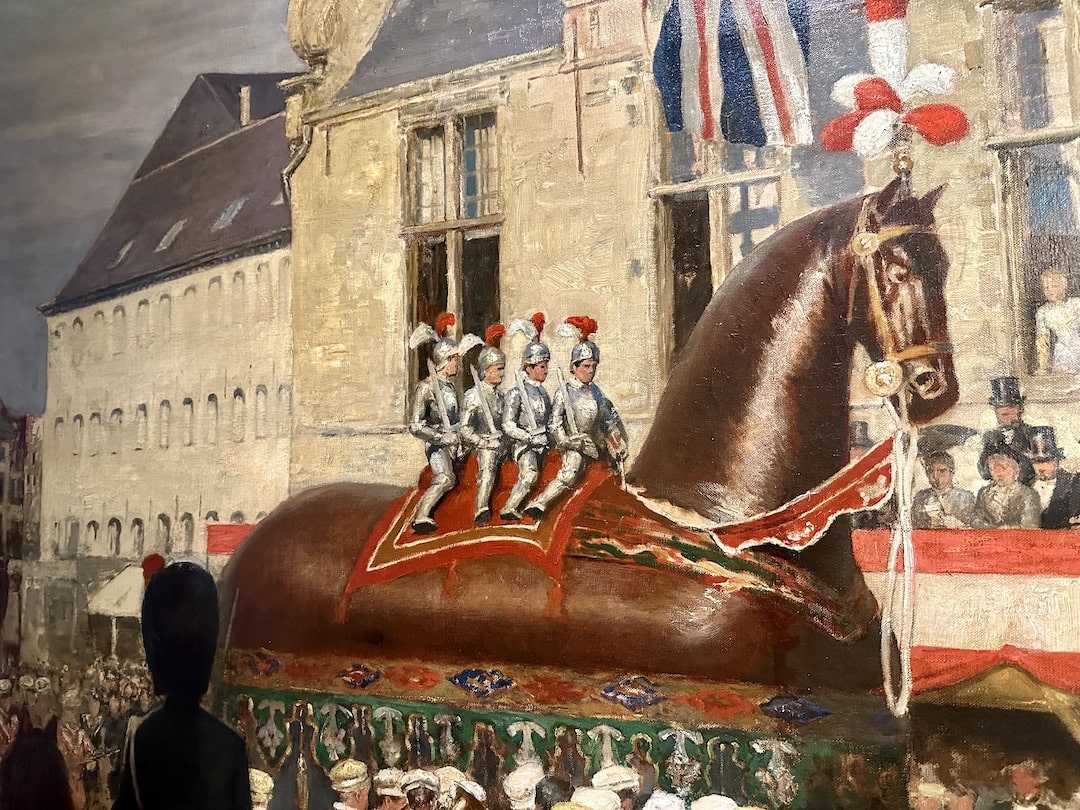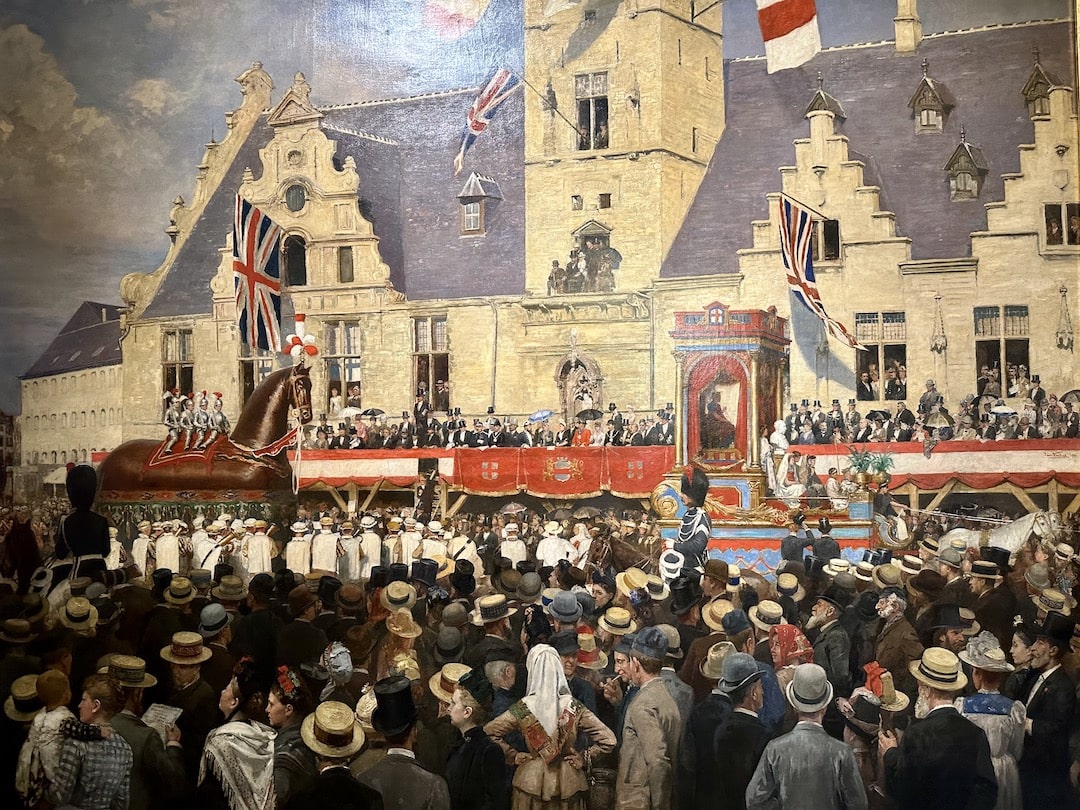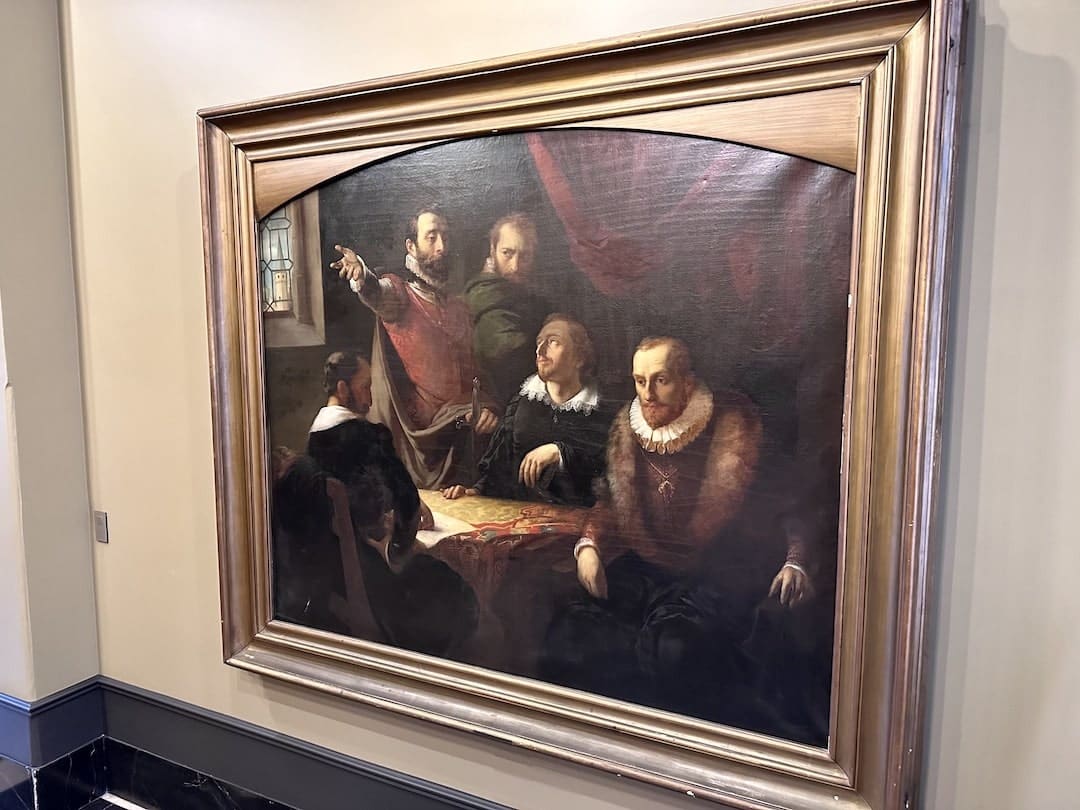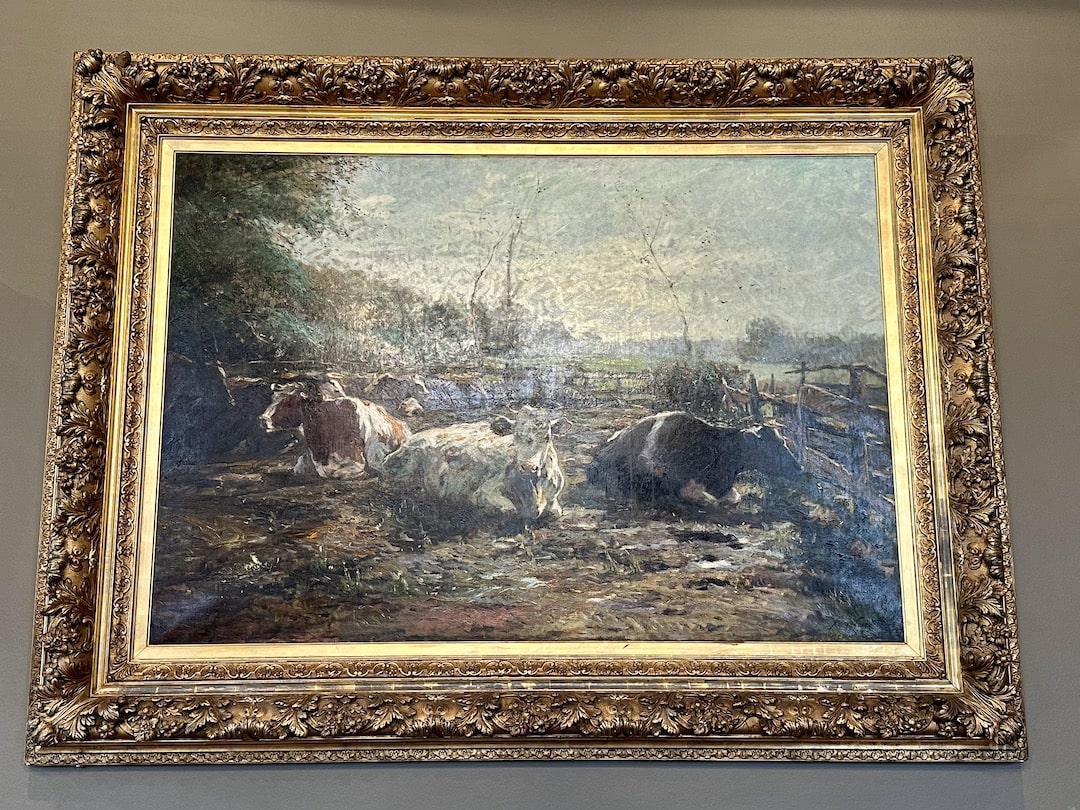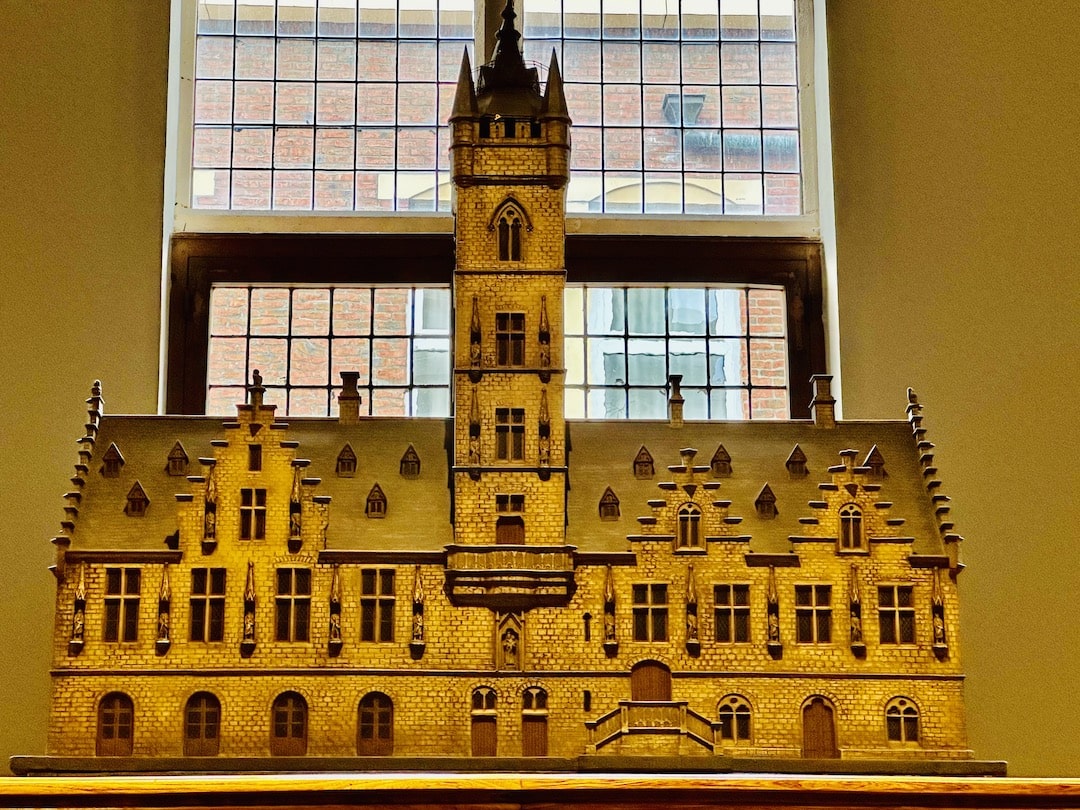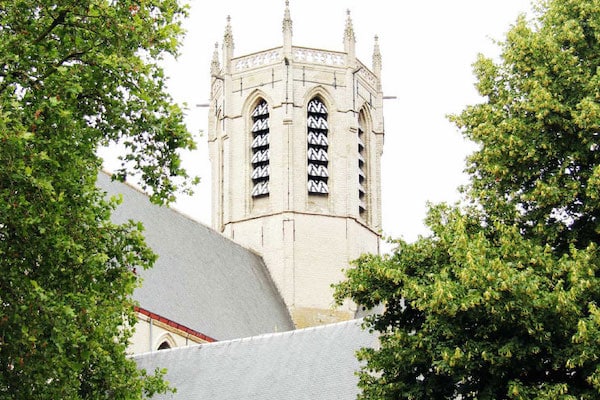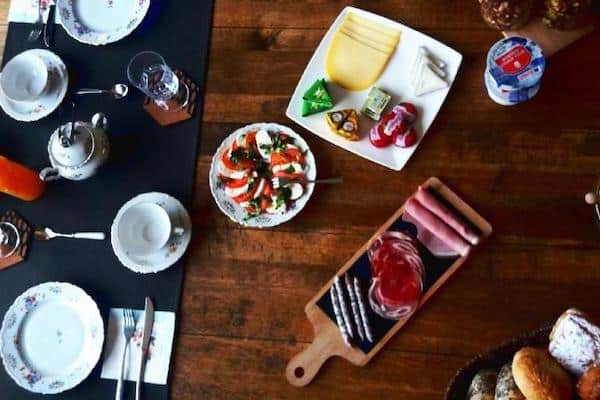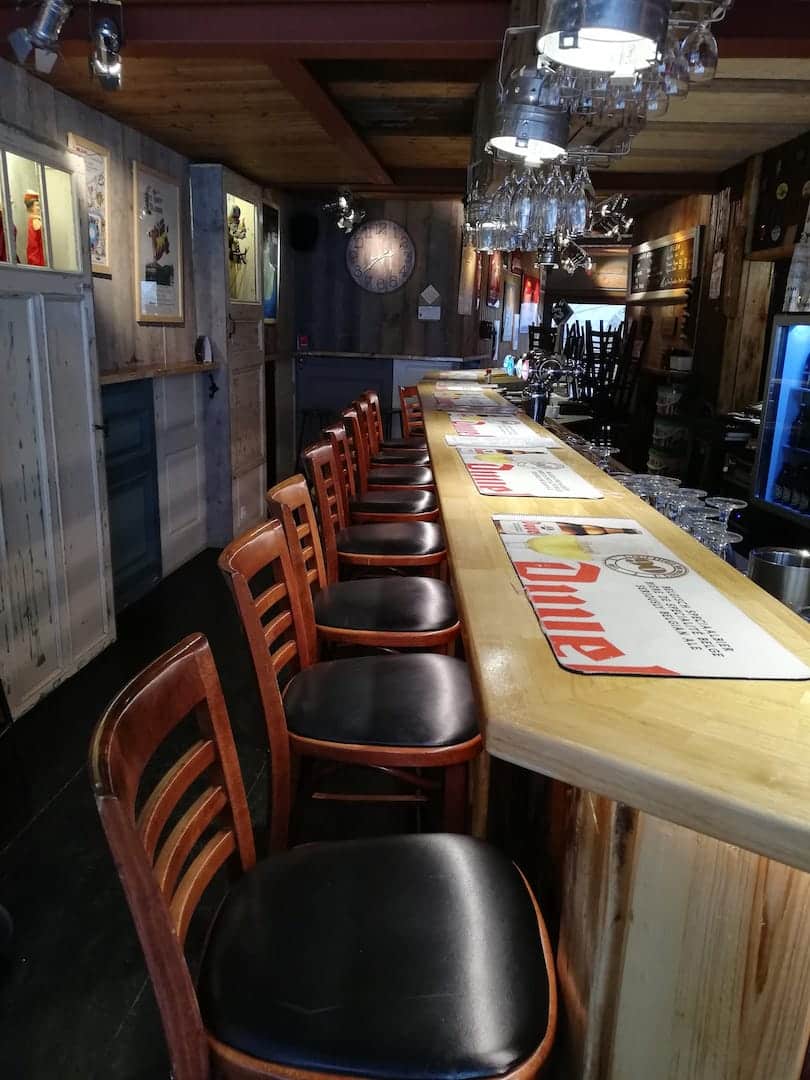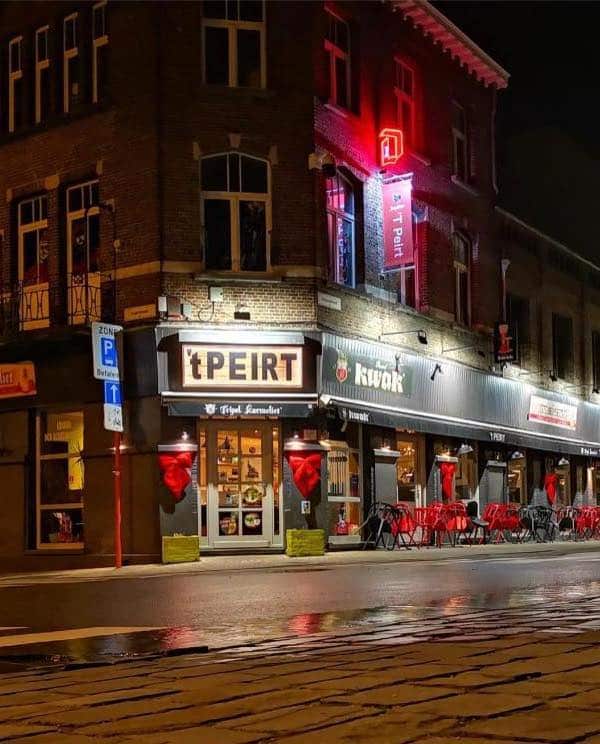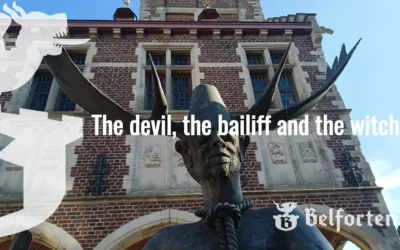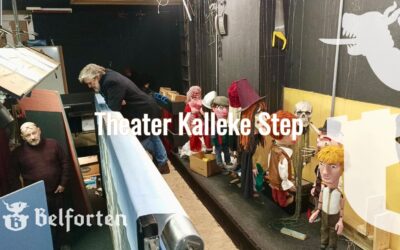Belfry of Dendermonde
Visit in March 2023
A warm welcome and a comprehensive tour
The Belfry and Town Hall of Dendermonde was visited in March 2023. Also read the post about the warm welcome by Patrick Segers and the comprehensive tour by city guide Gretel Laureys…
Belfry of Dendermonde
Concise history:
The Cloth Guild seeks space
In 1337, the lord of Dendermonde, Ingelram Ossemont granted permission for the construction of the new Cloth Hall. The reason for building the new Cloth Hall was that the Cloth Guild had too little space on the second floor of the Meat House (the butchers were on the first floor). By 1350, the construction of the new Cloth Hall was completed and the Belfry of Dendermonde was built against the Cloth Hall in 1377.
The construction of the Belfry was under the direction of master mason Michel van Melbrouc of Vilvoorde and master carpenter Boudewijn van den Cappellen. In 1378, construction was completed with the installation of the city clock. In a fireproof vaulted room on the second floor, the city’s charters and privileges were kept from then on.
Dendermonde changes hands
In 1347, the aforementioned lord of Dendermonde sold his seigniory to the French king. A year later, the latter in turn passed the seigniory to Louis of Male, Count of Flanders. He had the city walls raised and a second, wider moat built around the fortifications in 1368. Unfortunately, this could not prevent Dendermonde from falling into the hands of the Gentenaars during the Ghent revolt in 1380 and being completely looted. In 1384, the totally exhausted city and the Land of Dendermonde came into the possession of the Burgundian dukes.
First extension of the Cloth Hall
Between 1395 and 1405, the Cloth Hall was rebuilt and expanded with a new wing behind and to the right of the Belfry, which as a result was placed in the center. This stems from the decision in 1395 to convert the south facade into an alderman’s house. On the second floor to be exact. Despite Dendermonde being granted the rights to organize an Annual Fair in 1397, the city’s economic recovery took quite a long time after that.
Modernizations in the 16th century
In 1529, a clock, a jacquemart and a carillon with six bells were installed in the Belfry, cast by J. Waghevens. A two-headed eagle graced the top of the Belfry in 1548, and another year later the clockwork and carillon were replaced. The bells were again cast by J. Waghevens. The purchase of inn “Den Ooievaar” (in 1551) adjacent to the building significantly expanded the Schepenhuis. Thereby, side and front facade undergo renewal in Renaissance style.
Lost period
For the period from 1560 to 1732, all information has been lost due to German destruction in 1914. What is known is that in the period between 1732 and 1825 various members of the Leuven family Van den Gheyn cast 40 bells for the carillon. These were also miserably lost in 1914.
Expansion and thorough restoration in the 19th century
In the second quarter of the 19th century, the building was again expanded on the Dender side. This new building provides space for the Commerce Exchange, a room for the Reading Company, a large city party room, the city archives, the public library and, in 1862, the city fire department as well. Exterior features plastered facades in neoclassical style. This was followed by another restoration under the direction of city architect Edouard Bouwens between 1864 and 1896 in which the City Hall and Belfry were given new stepped gables and window openings in the form of printed pointed arches. Images of historical figures are placed in the gable niches.
The German destruction in 1914
As the Belgian army at Dendermonde blocked the German advance across the Scheldt, the German army wreaked havoc in Dendermonde in September. Not only by shelling but also by setting fire to the city, a trail of destruction was left that was never fully recovered. From September 4 to 6, 1914, virtually all of the city was burned. More than half of the homes and public buildings were reduced to ashes. Two more times the German army returned. In the process, a German shell hit the Belfry with a direct hit. The impact caused the bells to vibrate loose and crash down. In the fall, all the floors of the mezzanines were knocked away and the bells ended up on the first floor. When you visit the Belfry now you look from below straight up to the ridge.
The modern era
Under the direction of the architects Alexis Sterck and Fernand Ruddere, the Town Hall and Belfry were restored from 1920. Then, in 1924, city architect Fernand Ruddere replaced the 19th-century facades with neo-Gothic ones.
In 1925, the Belfry received a new carillon with 40 bells cast by O. Michaux that was again replaced in 1950 by 49 bells cast by M. Michiels. Another restoration of the carillon followed in 1975, replacing the bass bell and eight discant bells with ones cast by J. Sergeys. This will make it a complete carillon to the Malines standard. Until 1984, the building served as City Hall; since then, only Tourism Dendermonde has been housed in the building. In 2005, the carillon and tower clock will be restored once again. The latest renovation was in 2015 and 2016 in which the Cloth Hall was optimized for use as a tourist information office with a visitor center.
Sources:
-
#1 ‘Surveyor’s cityscapes mapped. Philips De Dijn 1626’, Reinoud Vermoesen, Georges Vande Winkel and Gabriël Redant, The Land of Aalst – Annual LXXI – 2019 – Number 1.
-
#2 2003, Along Flemish Belfries and Townhouses, Michiel Heirman, Davidsfonds Publishers, Leuven.
-
#3 Singing Towers,” Andreas Dill & Luc Rombouts, Davidsfonds Leuven, 2017.
-
#4 Website onroerenderfgoed.be, accessed March 6, 2023.
-
#5 Website toerismedendermonde.be, accessed March 6, 2023.
-
#6 Website scheldeland.be/belfort-dendermonde, accessed March 6, 2023.
-
#7 Website wikipedia.org/wiki/Belfort_of_Dendermonde, accessed March 6, 2023.
-
#8 Website familiekunde-dendermonde.be/welcome/history-of-dendermonde/, accessed March 6, 2023.
-
#9 Website mechelen.mapt.be/wiki/Jacob_Waghevens, accessed March 6, 2023.
Origins:
Built:
Building Material:
Style period:
Height:
Accessibility:
Belfort opening hours
June 1 – Sept. 30:
Tuesday – Friday from 9:30 a.m. to 4:15 p.m.
Saturday – Monday from 11 a.m. to 4:15 p.m.
Oct. 1– May 31:
Tuesday – Friday from 9:30 a.m. to 3:15 p.m.
Saturday – Sunday from noon to 3:15 p.m.
Monday closed
Information
Tourism: Call: +32 52 21 39 56 Mail: toerisme@dendermonde.be
Carillon Concerts
Every Sunday and Monday starting at 11 a.m. and in July and August every Thursday evening at 7 p.m.
Accommodation options in Dendermonde
Part of our pre-fun consists of booking accommodation. For us, combining a visit to a belfry with an overnight stay near it completes the experience and gives us more time to gather information.
B&B Dendernachten
Our vacation accommodation is located in the heart of the city, just a few steps from the historic and always bustling Grand Place. But also near a wide network of rural hiking and biking trails….
B&B Domus Portus
B&B Casa Cava
Food and drink
During our visit to Dendermonde, we visited several classrooms to have something to eat, drink and, above all, taste the atmosphere. After all, not only information hunger needs to be satisfied. Do you have another absolute tip where a visit to Dendermonde should be culinary or can you tip the ultimate pub? Then send a message to: info@belforten.com.
1. In the Poepekas
Bert’s fine nose for the best cafes brought us to this wonderful pub. The flag covers it and you realize yourself in a veritable puppet show with soon to be animated conversations. The visit was followed up the next day at Marionette Theatre Kalleke Step which is inextricably linked to the café.
2. Cafe Tavern ‘t PEIRT
Not to be missed is Cafe Taverne ‘t PEIRT when taking a walk along the “Oude Dender. Unlike the photo suggests, we are there early in the afternoon otherwise we would definitely have had a bite to eat there as well.
The three most recent posts
On this page we have collected all the relevant information for visiting this belfry. To keep this up to date, we are constantly on our way to one of the 56 belfries on the Unesco World Heritage List. Below are the latest additions.
The judge, the witch and the devil
Three special stories from the history of Tielt are symbolized and immortalized by three statues of Jef Claerhout.
Up in the belfry of Tielt!
Extensive message about the tour of the belfry of Tielt accompanied by a city guide and the subsequent ‘climb’.
Theater Kalleke Step
Notice of an unexpected visit to theater Kalleke Step in Grembergen during a planned visit to Dendermonde.
